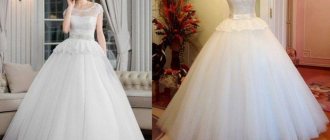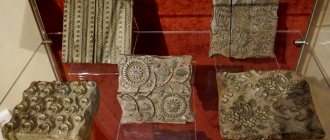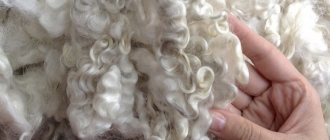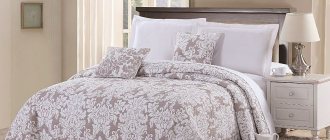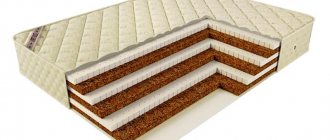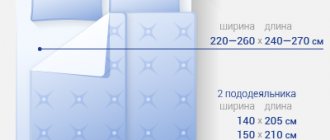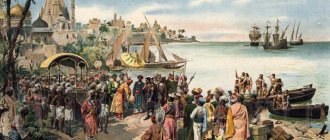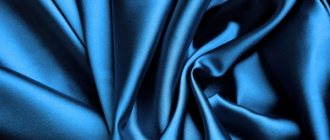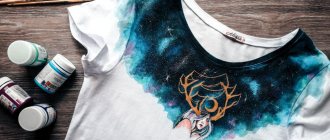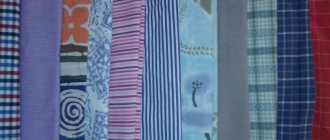Guipure and the history of its creation
Since ancient times, lace has attracted the eye and fascinated.
Graceful, flowing, thin, like a gossamer - that's all about it. The first information about lace comes to us from ancient times. Even on ancient Egyptian mummies, clothes with elements of lace embroidery were seen. The first laces were woven nets decorated with embroidery. Embroidery, which was the ancestor of lace, was widespread in many parts of the world, so it is impossible to clearly determine where lace fabrics originated.
Guipure dates back to the 16th century in Europe. The first information about him comes from Italy. The word guipure comes from the French “guiper” - “to braid”. The fabric consisted of separate woven elements connected to each other by airy thread bundles. Lace elements were woven with a needle or bobbins, using silk or cotton threads. Initially, guipure patterns were quite simple, and, as a rule, were floral patterns. “Venetian” guipure was especially famous. But fashion does not stand still, and lace patterns became more and more complex and intricate. In the 17th century, “voluminous guipure” with protruding elements appeared.
The area of guipure production also expanded. In the 17th century, a manufactory for the production of this material was opened in France. The main difference from French lace is the very small and elegant pattern, in contrast to the rather large Venetian print. For wealthy citizens, natural linen threads began to be used in the production of guipure, as well as gold and silver components were added. The cost of such guipures, of course, was high, and not everyone could afford them.
Separately, we should talk about guipure or, as it is also called, “stitch embroidery”. This technique developed at the end of the 19th century in Nizhny Novgorod and consisted of embroidery on a large-mesh mesh (cells with a side of 0.5-0.7 cm). The base mesh was filled with an openwork pattern, ranging from dense ornaments to light airy hems.
Production Features
proizvidstvo-1
proizvidstvo-3
Guipure is made in several ways.
- The classic method is “pulling”. The basis for the pattern is the mesh. Its size is from 0.5 to 0.8 cm. It is applied to the fabric and its position is noted. Then the warp and weft threads for “pulling” are determined. After all excess fibers are removed from the fabric, it has a loose appearance. In order to give it rigidity, the threads are twisted.
- Another method is based on the “etching” method. To do this, soluble fabric is used as a basis. A drawing is applied to it. Usually synthetic fabric (for example, vinyl) is used. Embroidery is done with cotton yarn. Then the resulting canvas is placed in boiling water for 20 minutes.
- Currently, spinning machines are used to produce fabric on an industrial scale. They perform the pattern according to a predetermined scenario. For production, both natural fabrics are used (in this case, the result is rigid, dense lace with a pronounced pattern) and synthetic ones (the result is a thin linen-type fabric).
The following threads are used for manufacturing:
- Cotton;
- Linen;
- Silk;
- Synthetic.
Properties and features of guipure
Currently, lace is produced using special machines - spinning machines. Modern knitting machines allow you to create a pattern of almost any complexity. To obtain a more acceptable purchasing price, as well as to increase the strength and wear resistance of the material, viscose or synthetic threads are added to its base. Quite often, lycra is used for the base. Guipures made from a mixture of cotton and nylon threads are very common.
Modern guipure is an openwork and transparent, but at the same time quite dense, quite hard to the touch fabric. All guipure canvases have a pronounced three-dimensional pattern, interconnected by a fine mesh. Depending on the ratio of openwork elements and the base mesh, guipure can look completely different. With a small number of dense areas of embroidery, guipure looks more delicate and airy, but at the same time loses its density and becomes very vulnerable to external influences. If the amount of base is too small and most of the fabric is covered with embroidery, then the fabric becomes dense and holds its shape well.
Since guipure consists of different threads, it is quite difficult to dye. Therefore, as a rule, stores offer plain guipures.
Guipure production technology
Of course, in the modern world, lace is no longer made by hand, but rather they resort to the use of specialized equipment; there are the following methods for making fabric:
- “Pulling” - a pattern is applied to the material and, as it were, all the excess fibers are pulled out. In order to remove the looseness of the fabric and make it durable, the resulting pattern is strengthened by upholstering it with additional thread.
- “Etching” - embroidery is made from synthetic soluble fabric, which is then dissolved in a special composition.
- Spinning machines - the pattern is created by programming.
Types of guipure
There are cotton, knitted, silk, and synthetic guipures.
- Printed guipure
- usually based on knitwear or satin with the addition of lycra. - Plain dyed guipure
. - Guipure leather
- is obtained by gluing guipure onto a very thin natural or artificial leather. - Elastic or stretch guipure
is a stretchy lace fabric with the addition of elastane. - Guipure cord
- in this type of guipure, an additional pattern is woven into the openwork elements using soutache thread or a thin cord. Due to this, the ornament receives additional relief. - Biflex guipure
is an elastic stretch guipure of high quality, characterized by the ability to stretch in both directions
Depending on the size and type of lace ornament, guipure is divided into: guipure with rigid lace, finely patterned, lace guipure, with a geometric or floral ornament, guipure mesh (a small amount of very small ornament)
Quite often, lurex and metanite are added to the composition of the main elements for greater attractiveness and to give a metallic shine.
Why guipure is always relevant
The history of guipure begins in the 17th century. It was then that the famous Venetian lace appeared. The material is a fabric assembled from lace elements using thin threads.
Over time, the lace fabric changed until it acquired the look familiar to us.
Main fashion trends of the year:
- using thick lace for sewing dresses without lining;
- the use of traditional black and white lace fabric, as well as colored options;
- combining lace with other fabrics - crepe, satin, wool, denim.
Designers often use lace fabrics with lurex in their collections and decorate products with sequins or rhinestones.
Features of care
Guipure, despite being a fairly tough fabric, requires special care.
It must be washed in warm water, at a temperature of approximately 30-40 degrees. Hand wash is preferred, but a washing machine can be used on the delicate or hand wash cycle. If a product made of guipure has few lace elements and the connecting mesh predominates, then it is still better to refuse automatic washing. The probability of the guipure breaking is quite high. Particularly thin and openwork guipures can become deformed and lose their shape when washed in a washing machine. Spinning guipure in a washing machine centrifuge is contraindicated. It is better to squeeze the products manually without using strong twisting or compression. The product must be dried flat, preferably on a horizontal surface.
Guipure should be ironed at low temperature, in the “Silk” mode. It is advisable to use humidifiers or damp gauze.
Story
According to most researchers, guipure. appeared in Italy, where for a long time there was a fashion for lace clothes. In ancient times, the entire Italian nobility preferred this particular fabric, finding it aristocratic and expensive-looking. It was in Italy, especially in Venice, that it was always famous for its lace. Here designers and fashion designers embroidered them with their own hands using special sticks. Guipure in Italy is an entire era, culture and national heritage.
The peculiarity of Italian fabric is that it smacks of historicity and originality. The thing is that the craftsmen did not keep up with the changing fashions, because they made guipure for an extremely long time, carefully and carefully. Due to this, lace looks so historical and individual, unlike many other fabrics and types of clothing. Initially, the fabric was created exclusively from natural materials. Such as: silk, cotton and linen. This is the special uniqueness of guipure.
Over time, with the advent of modern technologies, the hand-made work of creating guipure, of course, faded into the background. Of course, there are companies that have craftsmen on their staff who make fabric with their own hands, but there are fewer and fewer of them. Still, now this business is ruled by factory machines, which sew faster and have fewer problems with them. But be that as it may, guipure fabric in any case remains in demand and relevant.
What to sew from guipure
Since guipure is a transparent fabric, it itself is used only for sewing decorative and finishing elements: a collar, a small shelf or insert, gloves, elements of underwear. But guipure goes well with many fabrics, such as satin, silk, cream, etc. This combination is at once elegant and sophisticated, yet practical and functional. The base fabric adds the necessary strength to the guipure and keeps it from stretching and deformation, which makes the item more durable, but does not detract from its airiness and beauty.
Guipure dresses have been attracting numerous glances for many, many years; intricate patterns and weaves enchant and fascinate. It is not without reason that many stars and designers opt for evening dresses made of guipure. There is plenty of room for creativity! If you need an elegant, discreet option, opt for a guipure model with a matte lining to match the main material. Guipure dresses in neutral beige or cream colors are perfect for summer. They will make a wonderful ensemble with a classic jacket or a small bolero.
For a brighter look, consider a contrasting sheath dress. A dress made of black guipure with a lining of flesh-colored fabric looks very bold and sexy. This combination creates the effect of a naked body under a thin guipure outfit. A special niche is occupied by wedding guipure dresses. A short sheath dress, a long elegant mermaid dress, a frivolous vintage dress - the bride will be irresistible in any of these outfits. One of the most popular classic options is a fluffy dress with a guipure top.
Whatever the chosen style, the following remains unchanged: guipure is luxurious and beautiful in itself, therefore it practically does not require additional decorations and accessories. Excessive accessories can overload the dress and even make it vulgar.
Guipure tops and blouses deserve special attention. The choice of models is so wide that they will suit any wardrobe, from a business suit to shorts and jeans.
Composition and properties
Guipure looks beautiful and expensive due to the high-quality composition that makes this fabric so popular and good. Consists of some materials: cotton, silk, linen, polyester, viscose. It is made both by hand and using weaving machines. Lycra and other synthetics are added, which are necessary in this composition to give strength. The pattern with flowers is the most common version of guipure. The most expensive, high-quality versions of guipure fabric are made from the finest cotton, viscose, and silk threads. To add shine, lurex is added to the composition, and stretchy lycra thread is added for elasticity and comfort. In modern production you can often see canvas made of acrylic, elastin, polyester along with classic natural ones.
You are probably wondering what kind of fabric is guipure? Now let's talk about the properties of this fabric:
- A practical fabric that is easy to care for, that is, if you wash the guipure very often, the fabric will still not deteriorate. It is very durable;
- Beautiful aesthetic fabric. Any esthete will be delighted with guipure;
- Shape stability. The fabric material does not stretch;
- When wearing something made of guipure, you feel light, because the fabric weighs very little;
- You can wear something made of guipure and not worry about safety, because any such item has a gasket that allows the fabric not to come into contact with the skin. Thus, a person simply cannot experience allergies or skin irritations;
- Guipure is used not only in the production of clothing, but also for household items. The fabric is extremely versatile.
The properties and composition of the material create a beautiful, high-quality fabric that is pleasant and comfortable to walk in.
Kinds
There are many types of guipure, different models, options, different colors. It is divided into several types: mesh, knitwear, stretch, classic, metallic, wedding and macrame. In general, the progenitor of aristocratic high-quality guipure fabric was Venetian guipure. He is accustomed to complex, heterogeneous patterns, which are produced using high-quality threads, gold and silver.
During exclusively industrial production, during the manufacture of lace fabric, they began to add synthetics or synthetic threads to it, which made it possible to make products more durable and stable. Stretch guipure can be used to sew unique designs, as it stretches well and fits perfectly to any figure. The sign of elasticity is very important for each material. In this sense, guipure is second to none.
There is also guipure with lurex. In fact, this is a more festive model for an evening out. Interspersed with glitter give the material density and rigidity. With it, the fabric no longer seems so light, but it fits well and looks beautiful on the body.
In the modern world, there is already a mixture of guipure and knitwear. Such a product does not require different types of covers or gaskets in its arsenal and, to a greater extent, provides the chance to create many models with the presence of different elements. This combination looks extremely beautiful and delightful: white lace and a dark knitted base. Fashionable and elegant!
There is also guipure satin. This is a completely new type of two-layer fabric. It is very comfortable and elastic. The composition includes: stretch satin and guipure. Often complemented by patterns, thin threads, rhinestones and sparkles. Mainly used for sewing evening and wedding dresses.
If the clothes have some interesting pattern or even ordinary flowers, then most likely it is printed guipure. It is called so because of the technology used to print a design on fabric. In this case, such outfits are suitable for holidays and for regular walks on a daily basis.
The type of macrame guipure looks very expensive, beautiful and majestic. It is made from quality threads. Such fabric with light additions, trims and details is often in demand. It can be used not only in clothing, but also in the interior.
White guipure is very beautiful for wedding dresses. They are full of patterns, bright fibers, meshes and other decorations. Guipure fabrics abound in a variety of patterns, shades, types, and production techniques. In sets they harmonize perfectly with other textures. Although black guipure looks no worse.
| Classification | Intelligence |
| Classic | Regular lace |
| Knitted | Soft and elastic fabric |
| Guipure leather | Dense durable material |
| Metallic | Thick opaque lace |
| Stretch | Elastic material |
| Reticulate | Thin material |
| Plain painted | Dyed matter |
| Printed | Patterned fabric |
Types of fabrics
Guipure has a large number of varieties, among which are:
- classic - pure lace without additives;
- with lurex – thanks to lurex the fabric has a shiny sheen;
- stretch guipure - elastic openwork fabric containing lycra for a better fit;
- Guipure leather - canvas with increased density;
- mesh - thin fabric, with minimal inclusions of embroidery;
- metallic is an opaque dense material with shine.
When sewing clothes, openwork fabric is practically not used in its pure form because of its transparency. Most often it is complemented by a lining made of chintz, satin, corrugation and other materials. Or acts as a finishing element. Skirts, blouses, bed linen and underwear are made from guipure.
The material is very popular among manufacturers of elegant dresses, including wedding, cocktail and evening dresses. Dresses made of guipure on satin are very popular as wedding dresses. In addition, the fabric is used in sewing accessories (gloves, collars, cuffs, scarves) and interior items (pillows, bedspreads, curtains are decorated with fabric).
History of appearance
It is difficult to indicate the exact time of the invention of lace - archaeologists find individual fragments of outfits decorated with it during excavations of burials dating back to ancient Egypt. It is also impossible to name the country in which lace fabric was first produced. It was made by hand, using bobbins and needles. Needle lace was first produced in Italy in the 14th century, from where it spread throughout Europe. Renaissance dresses are replete with lace elements with intricate patterns.
Advantages and disadvantages of guipure
The advantages of the fabric include the following qualities:
- aesthetic appearance – products decorated with guipure are distinguished by their beauty and sophistication;
- due to its transparency, it has increased air exchange, which adds convenience when wearing things made from this material;
- it is lightweight - this allows you to wear it even during the summer heat;
- due to its versatility, it is used in decorating various household items;
- it is safe because items with it are mostly lined, which avoids contact with the skin.
Among the disadvantages of the material are the following:
- puffs easily form on the canvas, which requires careful handling of guipure items;
- Guipure with a large amount of lace on a mesh is hard, and with a small amount it can be easily damaged when worn and washed;
- due to the complex dyeing process, the range of colors of guipure items is small;
- Such material is quite expensive, due to the complex manufacturing process.
Nizhny Novgorod guipure today
Currently, JSC "Gipure" produces sets of bed and table linen, table runners, napkins, towels, interior items, as well as linen and cotton clothing decorated with artistic embroidery. Nizhny Novgorod guipure is classified as folk art crafts of significant cultural and historical value. The works of Chkalov craftswomen participate in various fairs and exhibitions, including international ones.
Address of JSC "Gipure": Nizhny Novgorod region, Chkalovsk, st. Belinskogo, 65
Lamp Towel “Festive” (300x65 cm): hold - 14 hours, machine embroidery - 17 hours, hand embroidery - 97 hours
Towel “Holiday” (300x65 cm)
"Alexander Nevsky Cathedral" and "Renaissance"
Panel "Chkalov's flight"
Panel “Mosca-850” (1997)
